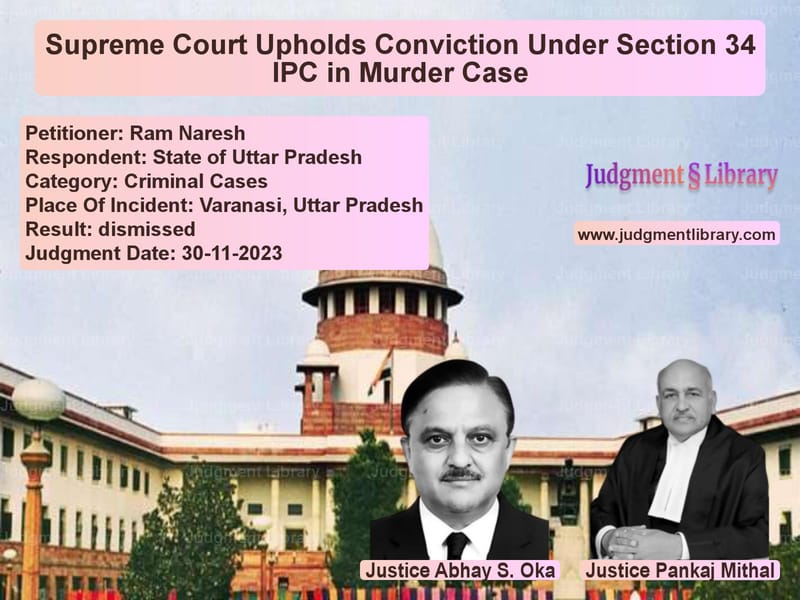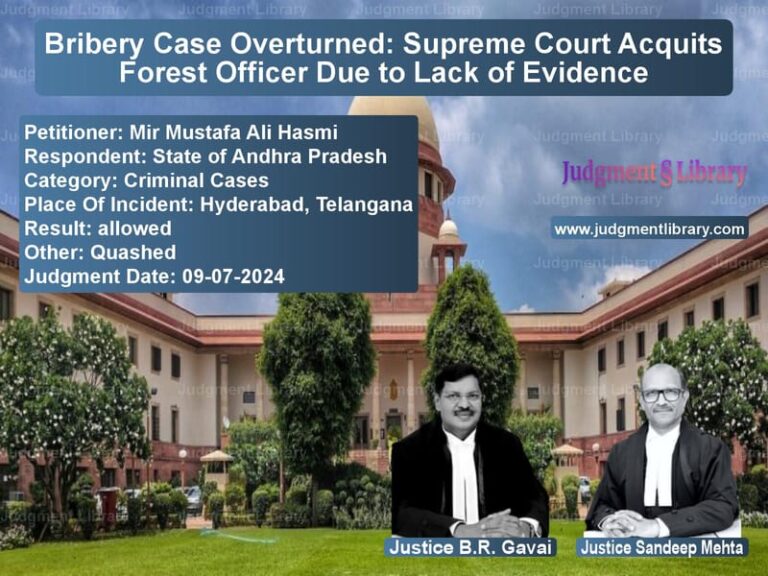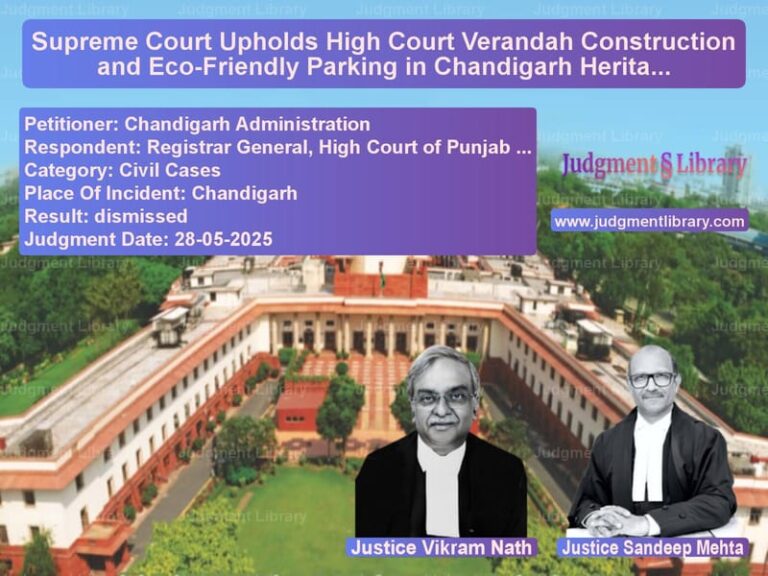Supreme Court Upholds Conviction Under Section 34 IPC in Murder Case
The Supreme Court of India recently upheld the conviction of Ram Naresh in a case involving Section 302 read with Section 34 of the Indian Penal Code (IPC). The Court examined the applicability of common intention under Section 34 IPC in a murder case, where multiple accused individuals assaulted the victim, leading to his death. The case provides clarity on the concept of common intention and collective liability in criminal law.
Background of the Case
The case involved an incident that occurred on October 18, 1982, in Varanasi, Uttar Pradesh. The First Information Report (FIR) was lodged by Balram, the brother of the deceased Ram Kishore. According to the FIR:
- At approximately 5:30 AM, Balram and his brother, Ram Kishore, were on their way to relieve themselves when they reached Babulal’s Dhaba.
- Four individuals, identified as Virender, Rajaram, Jogendra, and Ram Naresh, armed with lathis and an iron rod, emerged from the dhaba.
- The accused individuals shouted, “Kill him!” and surrounded Ram Kishore.
- They attacked him brutally, striking him with lathis and an iron rod.
- Despite shouting for help, assistance did not arrive in time, and Ram Kishore succumbed to his injuries.
The police registered a case under Section 302/34 IPC, and following an investigation, the accused individuals were tried and convicted for murder.
Legal Issues Raised
- Was there sufficient evidence to prove the common intention of all accused under Section 34 IPC?
- Did the appellant, Ram Naresh, actively participate in the crime?
- Did the trial court and the High Court correctly interpret the concept of common intention?
Arguments of the Appellant (Ram Naresh)
- The trial court failed to consider whether there was common intention among the accused.
- There was no evidence to establish a premeditated plan to commit murder.
- The High Court’s judgment also lacked specific findings on the presence of common intention.
- At most, the prosecution proved individual participation, but not a shared purpose.
Arguments of the Respondents (State of Uttar Pradesh)
- All accused persons acted together and delivered fatal blows to the victim.
- The accused arrived together, attacked together, and fled together, establishing a shared criminal intent.
- The prosecution presented strong eyewitness testimony, particularly from Balram (PW-1), who witnessed the entire attack.
- The collective action of the accused was sufficient to prove common intention, even if the attack was spontaneous.
Supreme Court’s Observations
1. Understanding Common Intention Under Section 34 IPC
The Court reiterated that Section 34 IPC applies when a criminal act is done by several persons in furtherance of a common intention. The presence of common intention is determined by:
- Pre-arranged planning or an understanding among the accused.
- Participation in the crime, either actively or in aiding the main offender.
- The nature and severity of the assault.
The Court cited its ruling in Krishnamurthy alias Gunodu & Ors. v. State of Karnataka (2022), stating:
“For Section 34 to apply, there should be common intention between the co-perpetrators, which means that there should be community of purpose and common design or prearranged plan. However, this does not mean that co-perpetrators should have engaged in any discussion, agreement, or valuation. Common intention can be formed just a minute before the actual act happens.”
2. Common Intention Can Be Formed on the Spot
The Court rejected the appellant’s argument that the lack of premeditation negated common intention:
“Common intention does not require long deliberation or preplanning; it can be formed moments before or even during the act.”
3. Direct Participation in the Assault
The Court noted that Ram Naresh was actively involved in the attack, wielding a lathi and striking the victim. His direct participation, combined with the coordinated attack, established his shared intent.
4. Testimony of Eyewitnesses
The Court upheld the credibility of Balram (PW-1), who gave consistent testimony about the attack:
“The prosecution’s witness remained unshaken in cross-examination, consistently stating that all four accused surrounded and assaulted the victim.”
5. High Court’s Findings
The High Court found that:
- The accused persons arrived together with weapons.
- They acted in unison to attack and kill the victim.
- The shared intent to kill was demonstrated by their actions.
The Supreme Court agreed with these findings and dismissed the appellant’s claims.
Final Judgment
- The Supreme Court dismissed the appeal.
- The conviction under Section 302 read with Section 34 IPC was upheld.
- The sentence of life imprisonment remained unchanged.
Key Takeaways
1. Common Intention Does Not Require Prior Planning
Even if an attack is spontaneous, the collective actions of the accused can establish common intention.
2. Simultaneous Participation Proves Shared Intent
When multiple individuals assault a victim together, it indicates a common intention to commit the crime.
3. Section 34 IPC Ensures Collective Responsibility
All individuals who participate in a group attack share liability for the final act.
4. Reliable Eyewitness Testimony Is Crucial
The Court reaffirmed the significance of consistent witness statements in proving common intention.
Conclusion
The Supreme Court’s ruling in this case strengthens the legal understanding of common intention under Section 34 IPC. The judgment ensures that individuals acting in concert to commit an offense are held equally responsible, preventing loopholes that could allow co-accused to escape liability. The verdict reinforces the principle that joint participation in a crime leads to joint responsibility, making it an essential precedent in criminal law.
Petitioner Name: Ram Naresh.Respondent Name: State of Uttar Pradesh.Judgment By: Justice Abhay S. Oka, Justice Pankaj Mithal.Place Of Incident: Varanasi, Uttar Pradesh.Judgment Date: 30-11-2023.
Don’t miss out on the full details! Download the complete judgment in PDF format below and gain valuable insights instantly!
Download Judgment: ram-naresh-vs-state-of-uttar-prade-supreme-court-of-india-judgment-dated-30-11-2023.pdf
Directly Download Judgment: Directly download this Judgment
See all petitions in Attempt to Murder Cases
See all petitions in Bail and Anticipatory Bail
See all petitions in Judgment by Abhay S. Oka
See all petitions in Judgment by Pankaj Mithal
See all petitions in dismissed
See all petitions in supreme court of India judgments November 2023
See all petitions in 2023 judgments
See all posts in Criminal Cases Category
See all allowed petitions in Criminal Cases Category
See all Dismissed petitions in Criminal Cases Category
See all partially allowed petitions in Criminal Cases Category







